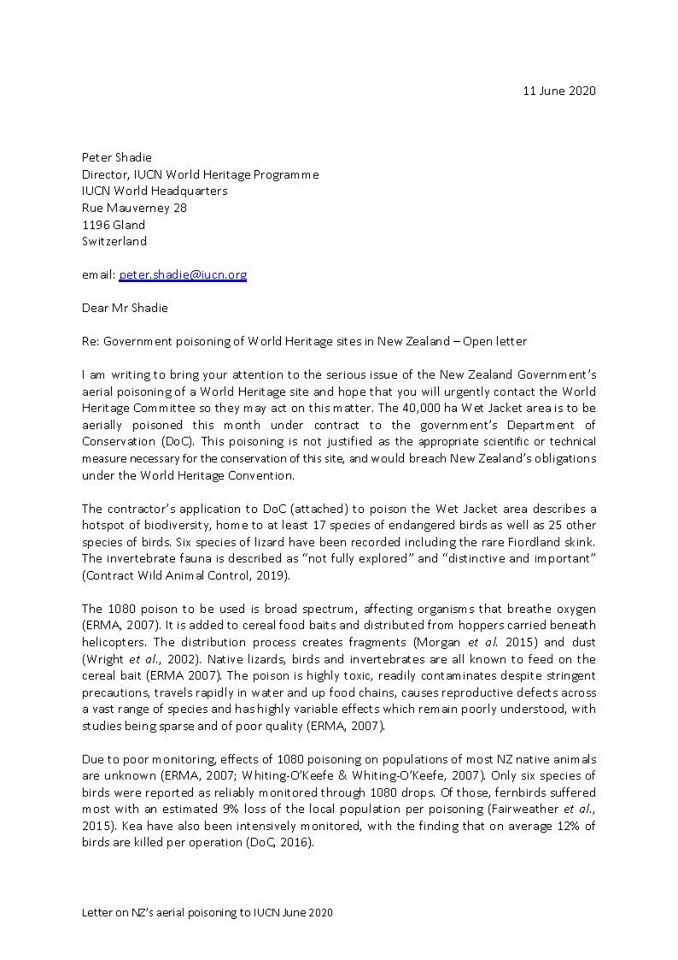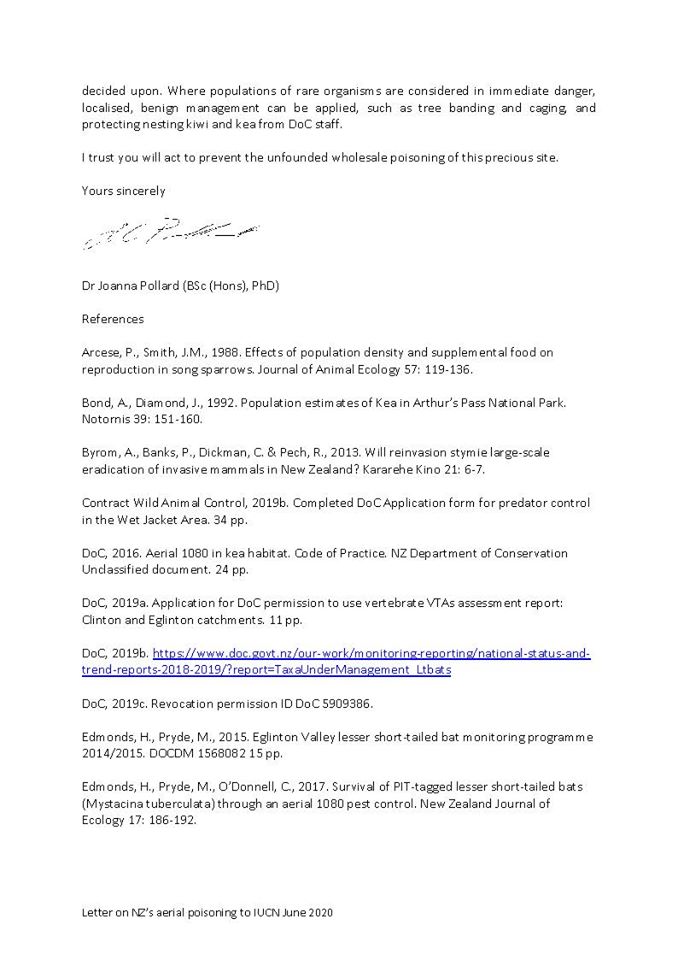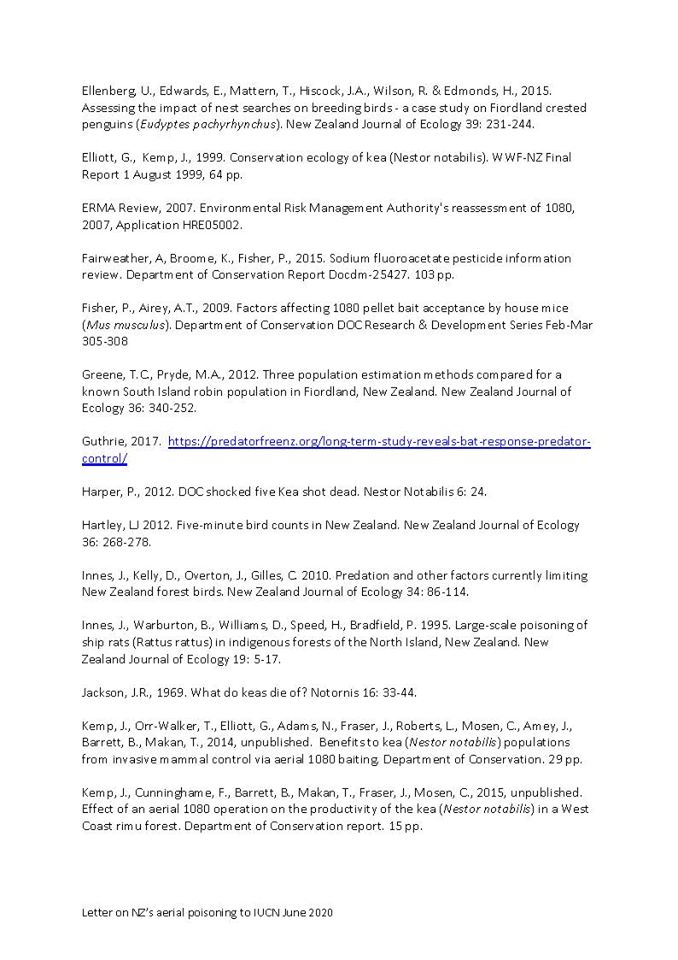Peter Shadie
Director, IUCN World Heritage Programme
IUCN World Headquarters
Rue Mauverney 28
1196 Gland
Switzerland
email: peter.shadie@iucn.org
11 June 2020
Dear Mr Shadie
Re: Government poisoning of World Heritage sites in New Zealand – Open letter
I am writing to bring your attention to the serious issue of the New Zealand Government’s aerial poisoning of a World Heritage site and hope that you will urgently contact the World Heritage Committee so they may act on this matter. The 40,000 ha Wet Jacket area is to be aerially poisoned this month under contract to the government’s Department of Conservation (DoC). This poisoning is not justified as the appropriate scientific or technical measure necessary for the conservation of this site, and would breach New Zealand’s obligations under the World Heritage Convention.
The contractor’s application to DoC (attached) to poison the Wet Jacket area describes a hotspot of biodiversity, home to at least 17 species of endangered birds as well as 25 other species of birds. Six species of lizard have been recorded including the rare Fiordland skink. The invertebrate fauna is described as “not fully explored” and “distinctive and important” (Contract Wild Animal Control, 2019).
The 1080 poison to be used is broad spectrum, affecting organisms that breathe oxygen (ERMA, 2007). It is added to cereal food baits and distributed from hoppers carried beneath helicopters. The distribution process creates fragments (Morgan et al. 2015) and dust (Wright et al., 2002). Native lizards, birds and invertebrates are all known to feed on the cereal bait (ERMA 2007). The poison is highly toxic, readily contaminates despite stringent precautions, travels rapidly in water and up food chains, causes reproductive defects across a vast range of species and has highly variable effects which remain poorly understood, with studies being sparse and of poor quality (ERMA, 2007).
Due to poor monitoring, effects of 1080 poisoning on populations of most NZ native animals are unknown (ERMA, 2007; Whiting-O’Keefe & Whiting-O’Keefe, 2007). Only six species of birds were reported as reliably monitored through 1080 drops. Of those, fernbirds suffered most with an estimated 9% loss of the local population per poisoning (Fairweather et al., 2015). Kea have also been intensively monitored, with the finding that on average 12% of birds are killed per operation (DoC, 2016).
The Application to poison the Wet Jacket area shows significant shortcomings, as follow.
Benefits
The reason given for poisoning the Wet Jacket area is to “protect the health and integrity of the flora and fauna susceptible to predation by rats, stoats and possums.” It lists animal species it considers particularly in need of protection: bats, kiwi, parakeets, kea and fiordland crested penguins.
These claims of susceptibility are not referenced or supported by scientific observations. In fact, it was concluded twice that predation was not a problem to kea (Jackson, 1969; Elliot & Kemp, 1999). Short-tailed bats were considered relatively safe from predators, being fast and agile, fiercely mobbing intruders and choosing winter roosts that were inaccessible (Lloyd et al., 2005). “Evidence” of predation of long tailed bats was just an observed association between low bat survival and high rat numbers (Pryde et al 2005; O’Donnell et al., 2011). Doc has attributed failures of some of its invasively monitored bird nests to predators, however they are not representative of undisturbed nests (Ellenberg et al., 2015).
Costs
Known costs left out of the Application include negative ecological effects from aerial poisoning. In many cases, rat numbers rebound to vast new heights within months (Innes et al., 1995; 2010; Powlesland et al., 1999; Ruscoe et al. 2008; Sweetapple et al., 2006). This effect can decimate prey such as invertebrates (Sweetapple & Nugent, 2007). Re-poisoning of rats is likely to become less and less effective due to the rats learning and developing physical tolerance (Byrom et al., 2013; Mitel, 2016; Pollard, 2016). Thus the Eglinton Valley (also in World Heritage site Fiordland National Park) has just received its fourth aerial poisoning in five years (2014, 2016, 2019, 2020). Despite increasing the intensity of the poisoning for rats in September 2019 (DoC, 2019a) another poisoning was carried out this May.
Mouse numbers usually increase soon after aerial poisoning (Innes et al., 1995; Sweetapple & Nugent, 2007, Ruscoe et al., 2008). The increases in rodents during the months after poisoning create ideal conditions to for stoats to flourish (Byrom et al., 2013). In addition, stoats that survived aerial poisoning were found to switch from eating rats to eating native birds (Murphy et al., 1988).
The Application contains no discussion of the conservation importance of the loss of kea, with previous studies indicating a 12% loss of local birds is expected. DoC claims that kea in remote areas are unlikely to get poisoned, however 9% of marked birds were killed by 1080 in an area chosen by DoC to represent remoteness (Kemp et al., 2016 unpublished). The total number of wild kea left is unknown and possibly less than 1000 ((Bond & Diamond, 1992; Harper, 2012; Roy, 2016).
Issues not addressed
Important issues left out of the Application include how much bait will enter the marine area; what effects there will be of baits, fragments and dust in the littoral zone (e.g. on penguins) and in the productive areas of shallow, still water; what will the effects be of the predicted “zero grazing ungulates” (being the last large grazing animals left); what are the chances of cold weather killing off rats in winter if they are left unpoisoned; should a highly diverse, unexplored ecological community be poisoned to try to make it better; what will be done if pest animal numbers are low, without poisoning.
DoC has a strong track record in misleading, pro-poisoning behaviour. It intrudes on nesting birds, attaches equipment to them and their nests, blames predators for nesting failures, then uses the poor nesting results to justify predator control (e.g. for kea (Kemp et al., 2014, unpublished), mohua (Elliott 1996), kiwi (Waterworth, 2019) and kaka (Moorhouse et al., 2003)). It quotes increased “nesting success” as an indication of a bird population’s positive response to poisoning, but nesting success is likely to increase if a population is culled (Nilsson 1984; Arcese & Smith 1988). “Five minute bird counts” are used by DoC to assess bird numbers. This method is notoriously unreliable (Westbrooke & Powlesland 2005; ERMA 2007; Green & Pryde 2012; Hartley 2012), due to major problems such as bird calls increasing after poisoning as birds try to find their dead partners and family, or search for new company.
DoC’s pro-poisoning bias and lack of scientific honesty are also apparent in its publications. For example a stoat plague that followed DoC’s aerial poisoning at Okarito (Kemp et al., 2015, unpublished) was truncated from the published graph (Kemp et al., 2017), despite this being an important outcome. In another example, in a study on bats after a 1080 operation, the contents of one bat roost tree had spilled onto open ground. Inspection revealed a baby bat with placenta attached, which tested positive for 1080. Other roosts in the study were inspected for dead and dying bats by roost camera “where practical” (Edmonds & Pryde, 2015). The published paper has a re-worded section of the original report that now insinuates all roosts were searched equally for dead babies (Edmonds et al., 2017).
The claim that some Eglinton Valley birds are prospering due to DoC’s 1080 poisoning (Minister of Conservation’s media release 11/4/20) is impossible to make: poison in bait stations and trapping are used to try to control mammals in the Eglinton Valley and any separate effects of 1080 cannot be assessed. Mohua (including some from the Wet Jacket area) were restocked there in 2010, 2015 and 2017.
Due to low rodent densities the Wet Jacket area poisoning was postponed in October 2019 (DoC, 2019c). The poisoning has since been promoted in the media as being needed to kill stoats, on the unscientific basis that local, heavily monitored kiwi chicks haven’t been surviving (Waterworth, 2020). These locally monitored kiwi weren’t even mentioned in the Application. There may be a very low stoat kill rate if there is a lack of poisoned rats for them to eat. If the poisoning proceeds regardless of low pest numbers, this will not be unusual. Makarora was poisoned in 2017 for rats despite low numbers (data accessed 22/3/17 via Official Information Act request); poisoning of Arthurs Pass in 2019 went ahead with no rats (data accessed 8/10/19) (mice were present but 1080 pellets are not usually eaten by mice (Fisher & Airey, 2009).
A fraction of the resources being used to poison the Wet Jacket area could support careful, scientific studies of the biodiversity and ecology of the area before a management plan is decided upon. Where populations of rare organisms are considered in immediate danger, localised, benign management can be applied, such as tree banding and caging, and protecting nesting kiwi and kea from DoC staff.
I trust you will act to prevent the unfounded wholesale poisoning of this precious site.
Yours sincerely
Dr Joanna Pollard (BSc (Hons), PhD)

See the IUCN reply to Dr Pollard below references.
References
Arcese, P., Smith, J.M., 1988. Effects of population density and supplemental food on reproduction in song sparrows. Journal of Animal Ecology 57: 119-136.
Bond, A., Diamond, J., 1992. Population estimates of Kea in Arthur’s Pass National Park. Notornis 39: 151-160.
Byrom, A., Banks, P., Dickman, C. & Pech, R., 2013. Will reinvasion stymie large-scale eradication of invasive mammals in New Zealand? Kararehe Kino 21: 6-7.
Contract Wild Animal Control, 2019b. Completed DoC Application form for predator control in the Wet Jacket Area. 34 pp.
DoC, 2016. Aerial 1080 in kea habitat. Code of Practice. NZ Department of Conservation Unclassified document. 24 pp.
DoC, 2019a. Application for DoC permission to use vertebrate VTAs assessment report: Clinton and Eglinton catchments. 11 pp.
DoC, 2019c. Revocation permission ID DoC 5909386.
Edmonds, H., Pryde, M., 2015. Eglinton Valley lesser short-tailed bat monitoring programme 2014/2015. DOCDM 1568082 15 pp.
Edmonds, H., Pryde, M., O’Donnell, C., 2017. Survival of PIT-tagged lesser short-tailed bats (Mystacina tuberculata) through an aerial 1080 pest control. New Zealand Journal of Ecology 17: 186-192.
Ellenberg, U., Edwards, E., Mattern, T., Hiscock, J.A., Wilson, R. & Edmonds, H., 2015. Assessing the impact of nest searches on breeding birds – a case study on Fiordland crested penguins (Eudyptes pachyrhynchus). New Zealand Journal of Ecology 39: 231-244.
Elliott, G., Kemp, J., 1999. Conservation ecology of kea (Nestor notabilis). WWF-NZ Final Report 1 August 1999, 64 pp.
ERMA Review, 2007. Environmental Risk Management Authority’s reassessment of 1080, 2007, Application HRE05002.
Fairweather, A, Broome, K., Fisher, P., 2015. Sodium fluoroacetate pesticide information review. Department of Conservation Report Docdm-25427. 103 pp.
Fisher, P., Airey, A.T., 2009. Factors affecting 1080 pellet bait acceptance by house mice (Mus musculus). Department of Conservation DOC Research & Development Series Feb-Mar 305-308
Greene, T.C., Pryde, M.A., 2012. Three population estimation methods compared for a known South Island robin population in Fiordland, New Zealand. New Zealand Journal of Ecology 36: 340-252.
Guthrie, 2017. https://predatorfreenz.org/long-term-study-reveals-bat-response-predator-control/
Harper, P., 2012. DOC shocked five Kea shot dead. Nestor Notabilis 6: 24.
Hartley, LJ 2012. Five-minute bird counts in New Zealand. New Zealand Journal of Ecology 36: 268-278.
Innes, J., Kelly, D., Overton, J., Gilles, C. 2010. Predation and other factors currently limiting New Zealand forest birds. New Zealand Journal of Ecology 34: 86-114.
Innes, J., Warburton, B., Williams, D., Speed, H., Bradfield, P. 1995. Large-scale poisoning of ship rats (Rattus rattus) in indigenous forests of the North Island, New Zealand. New Zealand Journal of Ecology 19: 5-17.
Jackson, J.R., 1969. What do keas die of? Notornis 16: 33-44.
Kemp, J., Orr-Walker, T., Elliott, G., Adams, N., Fraser, J., Roberts, L., Mosen, C., Amey, J., Barrett, B., Makan, T., 2014, unpublished. Benefits to kea (Nestor notabilis) populations from invasive mammal control via aerial 1080 baiting. Department of Conservation. 29 pp.
Kemp, J., Cunninghame, F., Barrett, B., Makan, T., Fraser, J., Mosen, C., 2015, unpublished. Effect of an aerial 1080 operation on the productivity of the kea (Nestor notabilis) in a West Coast rimu forest. Department of Conservation report. 15 pp.
Kemp, J., Hunter, C., Mosen, C., Elliott, G., 2016, unpublished. Draft: Kea population responses to aerial 1080 treatment in South Island landscapes. Department of Conservation, 14 pp.
Kemp, J., Mosen, C., Elliott, G., Hunter, C., 2018. Effects of the aerial application of 1080 to control pest mammals on kea reproductive success, New Zealand Journal of Ecology 42: 158-168.
King, 1984. Immigrant Killers. Introduced Predators and the conservation of birds in New Zealand. Oxford University Press.
Mitel, S., 2016. https://timnovate.wordpress.com/2016/12/31/the-mice-and-rats-are-winning/
Moorhouse, R., Greene, T., Dilks, P., Powlesland, R., Moran, L., Taylor, G., Jones, A., Knegtmans, J., Wills, D., Pryde, M., Fraser, I., August, A., August, C. 2003: Control of introduced mammalian predators improves kaka Nestor meridionalis breeding success: reversing the decline of a threatened New Zealand parrot. Biological Conservation 110: 33–44.
Morgan, D., Hickling, G. 2000. Techniques Used for Poisoning Possums, in TL Montague (ed. The brushtail possum: biology, impact and management, Manaaki Whenua Press, Lincoln, pp. 143-153.
Murphy, E., Clapperton, B., Bradfield, P., Speed, H. 1998. Effects of rat-poisoning on abundance and diet of mustelids in New Zealand podocarp forests. NZ J Zoology 25: 315-328.
Nilsson, S.G., 1984. The evolution of nest-site selection among hole-nesting birds: The importance of nest predation and competition. Ornis Scandinavica 15: 167-175.
Pollard. J.C., 2016. Aerial 1080 poisoning in New Zealand: Reasons for concern.
Powlesland, R., Knegtmans, J., Marshall, I. 1999. Costs and benefits of aerial 1080 possum control operations using carrot baits to North Island Robins (Petroica australis longipes), Pureora Forest Park. NZ J Ecology 23: 149-159.
Roy, E.A., 2016. New Zealand kea, the world’s only alpine parrot, faces extinction
Ruscoe, W., Sweetapple, P., Yockney, I., Pech, R., Barron, M., Cave, S., Ramsey, D. 2008. Interactions of mammalian pest populations following control. Kararehe Kino Vertebrate Pest Research 13: 4-6.
Sweetapple, P., Nugent, G., Poutu, N., Horton, P. 2006. Effect of reduced possum density on rodent and stoat abundance in podocarp-hardwood forests. Science for Conservation 231. 25 pp.
Sweetapple, P & Nugent, G 2007 Secondary Effects of Possum Control. Kararehe Kino 11: 9-10.
Waterworth, K., 2019. https://www.odt.co.nz/regions/southland/stoat-chick-toll-erasing-tokoeka
Waterworth, K., 2020. https://www.odt.co.nz/regions/fiordland/poison-drop-stop-predation-kiwi
Westbrooke, I.M., Powlesland, R.G., 2005. Comparison of impact between carrot and cereal 1080 baits on tomtits (Petroica macrocephala). New Zealand Journal of Ecology 29: 143-147.
Whiting O’Keefe, P., Whiting-O’Keefe, Q., Aerial monofluoroactate in New Zealand’s forests. An appraisal of the scientific evidence. 89 pp.
Wright, G., Booth, L., Morriss, G., Potts, M., Brown, L., Eason, C. 2002. Assessing potential environmental contamination from compound 1080 (sodium monofluoroacetate) in bait dust during possum control operations. New Zealand Journal of Agricultural Science 45: 57-65.
IUCN’S REPLY TO DR POLLARD:







Recent Posts
- Open letter to IUCN World Headquarters – Government poisoning of World Heritage sites in NZ
- Nonessential services in conservation
- Tragedy of kea easily avoided
- Is 1080 “moderately humane”?
- Is DoC looking after our insects?
- Where does 1080 poison go in water?
- Time to think about kea
- Letter to Mike Slater, DOC, Re: Aerial1080 in Arthurs Pass National Park
- Science against 1080
- 20 Reasons why DoC should not poison kea habitat
- Loss of science quality in NZ is having dire consequences
- Response to the Department of Conservation’s reply to “Aerial 1080 poisoning in New Zealand: reasons for concern”
Header Image by mohamed Hassan from Pixabay (text added)






You must be logged in to post a comment.